REYKJAVIK - Gli esperti sono quasi certi che tra pochi giorni il vulcano islandese Grimsvötn entri in eruzione, facendo nascere timori per uno stop dei voli in Europa come avvenuto in primavera per le nubi di ceneri emesse dal vulcano Eyjafjöll.

I segni premonitori sono chiari per geologi, vulcanologi e meteorologi: il livello del fiume Gigja è triplicato nel corso della notte tra il 31 ottobre e il 1° novembre, come ha specificato Gunnar Sigurdsson, dell'Ufficio meteo islandese. Il Gigja è il corso d'acqua che scende dal Vatnajökull, il ghiacciaio più grande d'Europa, sotto il quale c'è il cratere del Grimsvötn nel sud-est dell'Islanda. Il calore provocato dall'afflusso di lava fonde il ghiacciaio per uno spessore di 200 metri sopra il vulcano e aumenta il livello dell'acqua che si accumula nel cratere fino a traboccare nel Gigja. Ma più trabocca, minore è la pressione che tiene tappato il cratere e quindi se il livello dell'acqua scende maggiori sono le probabilità di un'eruzione, «a condizione che il volume del magma sia sufficiente», ha precisato il geologo Thorunn Skaftadottir. «Non so quando il livello limite sarà raggiunto, ma penso che sia una questione di giorni».
Questo l’articolo originale, estratto dal Canadian Express.
REYKJAVIK, Iceland — Torrents of water are pouring from a glacier that sits atop Iceland's most active volcano, an indication that the mountain is growing hotter and may be about to erupt, scientists said Monday.
The flood that began Thursday at the Grimsvotn volcano is similar to one in 2004 that lasted five days and ended with an eruption that disrupted European air traffic, University of Iceland geophysicist Pall Einarsson said.
In April, millions of air travellers around the world were grounded when ash from Iceland's Eyjafjallajokul volcano led most northern European countries to close airspace for five days.
There are no signs yet of the underground tremors that would signal an eruption at Grimsvotn, Icelandic Meteorological Office geophysicist Gunnar Gudmundsson said.
Grimsvotn lies under 650 feet (200 metres) of ice on the Vatnajokull glacier in southeast Iceland. In addition to 2004, it erupted in 1998 and 1996, causing flooding to a largely uninhabited plain around it.
The flooding triggered by hot molten rock, or magma, from the volcano has been expanding a lake underneath the glacier, building pressure strong enough to send water pouring from under the ice cap.
A rugged island in the north Atlantic, Iceland is one of the world's most volcanically active countries.
Copyright © 2010 The Canadian Press. All rights reserved.